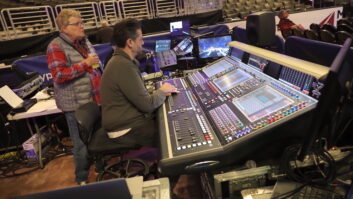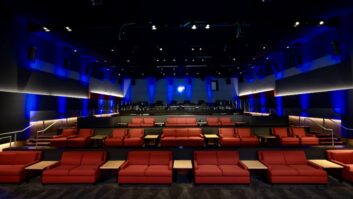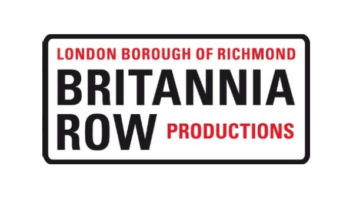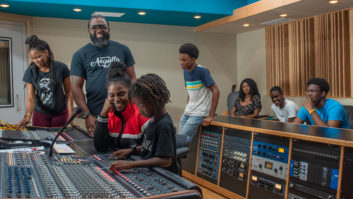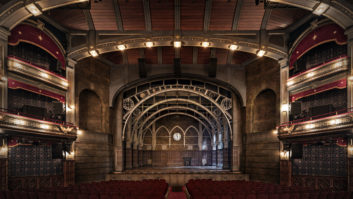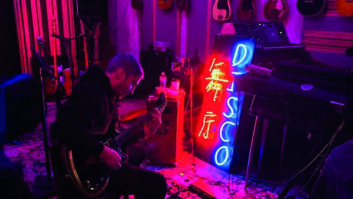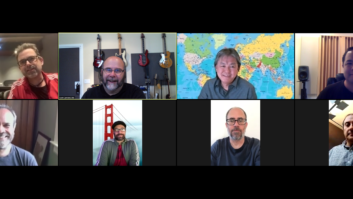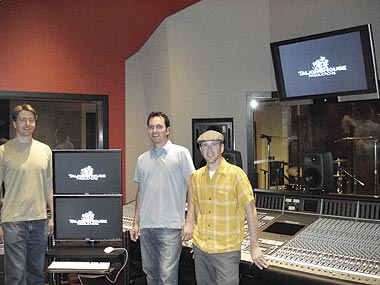

From left, in Talking House Studio A: chief engineer Peter Krawilec, engineer Justin Lieberman and producer Paul Ruxton
Photo: Robert Wolsch
Records are now tracked at a home in Malibu and mixed in a cottage in upstate New York. Scores are prepped on a laptop in Miami, brought to a Czech stage for live strings, then mixed and posted at a facility in London. Videogame programmers will likely never meet any of the dozen or more composers, effects editors and mixers who post their tracks to an FTP site. There’s no question that ours is an industry in transition, especially on the production end. But it’s still refreshing to hear that creative minds can come together in a single space and make music.
That’s the thought behind Talking House Productions and its companion studios. Six producers — John Paulsen, chief engineer Pete Krawiec, pc munoz, Paul Ruxton, Stephen Smith and Marc Weibel — co-founded the company with former Seagate CEO and songwriter Steve Luczo. Each is responsible for bringing in projects; others contribute as needed, though the charter assumes and declares a shared vision: to develop local talent.
“The music scene in San Francisco is exploding right now,” says Paulsen, company president. “So many talented bands and songwriters are giving it a go, and the club scene is growing again. There are artists here looking for someone who believes in their songs and has a philosophy that content is king, that content takes time and nurturing and ears and support to develop, and that artists deserve to be treated like partners for the long-term.”
It sounds a bit like A&R of yore, and it is. But then there is so much more, from videotaping sessions for vlogs (and straight-up blogs) to direct promotion via cell phones to traditional film and TV sync licensing. They do business, they do art, they do promotion, touring — the whole bit. Though they have a record label, they don’t want to be a label, so they form distribution “partnerships.” They are all well-versed in D.I.Y. marketing and support. And they know new media. But for two years, they had no studio, so they worked primarily out of John Lucasey’s Oakland, Calif., facility, Studio 880, a home they were grateful for while the Walters-Storyk Design Group laid out plans for Talking House.
John Storyk, principal designer, got involved early through connections with Luczo and Jack Leahy, a friend and owner of Crescendo! and the late Russian Hill Recording, who was also a mentor and colleague of a few of the producers. “Because of the way they wanted to work, we eventually found an appropriate warehouse-style building with very few columns and excellent height,” Storyk says. “Additional height and daylight was created by adding a 10-foot clear-story skylight to the live room. The initial program called for multiple control rooms with a single, large live room and iso booths, where every room could see at least 80 percent of the other rooms. Critical to the acoustic design was that all control rooms be working at the same time. We had done this before, but it’s not easy. There is lots of glass and tremendous demands for isolation. The basis for construction is that all rooms are separate ‘split concrete slabs,’ with wire management mostly in below-floor troughs. Room-to-room isolation is ensured with triple-wall construction, including sand-filled concrete block partitions. Extensive predictive auralization and reflection analysis was performed numerous times, allowing us to ‘listen’ to the rooms from the calculated impulse responses before they were built.”
The two-story building is actually split in two, with a little less than half devoted to a gallery space for art exhibitions and private quarters. The studio side, however, is all business, with Studio A housing an SSL 9000 K purchased from the defunct Hit Factory through broker PAD. On each side, and beginning the 180-degree arc, are two good-sized iso booths, flanked by opposing and identical Digidesign D-Command ICON rooms. Genelec 8050As provide 5.1 monitoring throughout, augmented by 1035B mains soffited in the SSL room. Three Dolby Lake processors manage the monitoring systems, the first we’ve heard of in a studio situation. Each room has 72 channels of Pro Tools HD, easily shared for big projects, and they still love 2-inch tape. Even the large, open Gallery is wired for tracking and playback.
“Above all, we were looking for flexibilty and ‘nimbleness,’” says Paulsen. “We can go old-school with the SSL onto 2-inch tape; we can dump to Pro Tools or begin with Pro Tools. We place a real emphasis on scoring here — it’s easily half of what we do. We can start with an improvised jam in the live room and add textures in our Pro Tools and MIDI-focused rooms. We can compose in MIDI, on laptops or in the rooms for two days, then add that one critical live element. We can do any one of these or all of them seamlessly because all the rooms are tied and work together. I don’t think it’s strange that the artistic side of us believes it’s crucial to have a vintage B3, Rhodes and Wurlitzer, and also crucial to have the new Muse Receptor. The gear is a perfect complement to the style we have as producers and the way the studio was set up.”
The Talking House team knows they aren’t reinventing the wheel here in terms of production style or artist development. But what’s different between Then and Now is the sheer number of outlets and opportunities for music to find its way out into the world. The model is in transition. There are no rules. But Talking House is definitely now in the Game.
For a look at Storyk’s floor plans, full design and build credits, and the complete Paulsen interview, visit
mixonline.com. For more on Talking House, visit
www.thpro.com.

